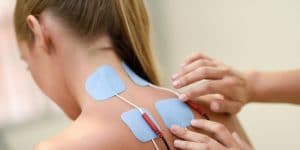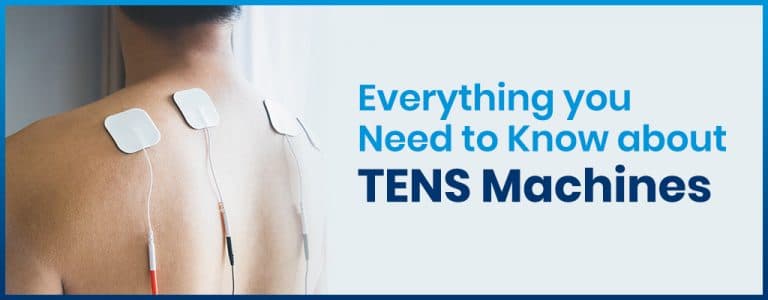A growing number of health professionals and individuals combatting back pain and other chronic conditions are turning to TENS (Transcutaneous Electrical Nerve Stimulation) machines for fast and non-invasive temporary or even long-lasting relief. Independent Living Specialists stocks a full complement of machines in its stores across Australia.
The increased use of this type of therapy makes sense – TENS machines offer sustainable pain management and a potential alternative to painkiller medications, some of which can be addictive or cause adverse side effects. Additionally, the small, battery-operated devices, first patented in 1974, are portable and easy to use: they can be hooked to your belt or placed in your pocket or purse.
Using them is equally simple. You place two adhesive electrode pads (or four, for maximum benefit) to the affected area of your body and your TENS machine provides low-voltage electric pulses. You’ll feel some pins-and-needles. But that’s it – with the exception of pain relief.
Pains TENS Machines Can Address
TENS machines available at Independent Living Specialists can be your “go-to” – and fast-acting – solution to help reduce pain and muscle spasms caused by numerous conditions, including:
- back pain caused by spine degeneration, disc problems or failed back surgery
- nerve pain (neuropathy) from conditions such as chronic regional pain syndrome (CRPS), fibromyalgia or diabetes
- cancer-related pain, phantom-limb pain (a chronic pain syndrome following limb amputation) and migraine or chronic tension-type headaches
- other applications including acute pain, arthritis, menstrual period pain, pelvic pain caused by endometriosis, knee pain, neck pain, sports injuries, obstetric care and bladder-stone removal
TENS machines also are utilised for muscle soreness from overuse, inflammatory conditions and both rheumatoid and osteoarthritis, as well as after surgery for incision or post-operative pain (e.g., joint replacement, cardiac procedures, various abdominal surgeries or cesarean sections). The machines also can improve blood circulation, which in turn is beneficial in dealing with arthritis, aches and pains, as well as improving sleep patterns.
And just over 20 years ago, in 1987, a specialised TENS machine – designed to address pain during labour – was created in Australia. Now, a small handheld device enables mothers in labour to manage the pain for themselves – often, for several hours at a time. During pregnancy, it’s important to note that TENS machines should only be used under the supervision of a healthcare professional and only during the third trimester.
How TENS Machines Reduce Pain
TENS machines are believed to alleviate neuropathic pain (pain due to nerve damage) by activating opioid receptors in the central nervous system. They differ from EMS, or electrical stimulation machines, which stimulate muscle cells to induce muscle contraction.
On a high pulse rate, the small electrical impulses are thought to block and/or reduce the pain signals going to the spinal cord and reaching the brain, which may help relieve pain and relax muscles. Conversely, on slower rate, it’s believed they may also stimulate the production of endorphins, which are the body’s natural painkillers.
The machines have controls that permit you to choose – through intensity, frequency and duration settings – an appropriate level of pain relief. This puts you in charge of your body. It’s likely that you will need to experiment with the controls at first in order to arrive at the settings that work for you. Once you have determined the settings, you will be able to use the TENS machine easily to relieve your pain.

How to Effectively Use Your TENS Machine
Accurate electrode placement is essential to the effectiveness of your TENS machine. Your physical therapist or the instruction booklet that is provided with your machine will be very helpful in that regard.
Your machine’s electrode pads need to be located in proximity to the involved nerves and/or the location of your pain. Most frequently, you will be instructed to place the electrodes either directly over your painful area or on either side of your pain.
It’s important to remember:
- The pads need to be at least one inch apart
- Turn the machine off while you position the pads
- If your machine has red and black electrode pads, ensure you position the black electrodes away from your torso, with the red electrodes closer to your torso
Other approaches to positioning your electrode pads can be used if you don’t get the desired relief from placing the pads directly over or surrounding the painful area. As an alternative, your physical therapist may recommend that you place the electrodes over the area where the spinal nerve root that supplies the painful area exits the vertebrae. Another approach is to position the electrodes over spots in your muscles called trigger points – these are areas of hyper-irritability in your muscles that can cause chronic pain. Your physical therapist can identify any trigger points for you. Research studies also are focusing on the intersection of acupuncture and TENS therapy and have determined that TENS pad electrode pads applied over acupuncture sites reduces pain and may be more effective than when applied over non-acupuncture sites.
Combatting specific pains with TENS Machines
Knee pain: Joint pain, overall, should be addressed through a combination of clinical treatment, medication and TENS treatment. The TENS part likely would be as follows: place the electrode pads either on the sides of your knee, the back of your knee or the front of your knee. Most often, if you are using two pads, you will position a pad on each side. If you are using four electrodes, you can place one above and one below your knee, as well.
Fibromyalgia: Individuals with fibromyalgia frequently can’t do the exercise necessary to relieve their pain because the pain is just too intense. With a portable or mini TENS machine, however, an individual can place the electrode pads where the pain is the worst. He or she can then engage in the needed exercise while the TENS machine is keeping the pain under control.
Labour pain: The TENS machine is used in the early stages of labour when regular contractions or backache usually begin. Two of the pads are placed on either side of your spine, with the tops of the pads at about bra-strap level. The other two are positioned lower down, at about the level of the dimples on the lower back. The machine starts with the controls at the lowest setting and is turned up gradually as contractions get stronger or when back pain gets worse. There even is a “boost button” to use when contractions are at the worst.
Headaches: Individuals address their intense headaches by using a TENS machine to relax tight muscles. They place the electrodes on the back of their necks while lying down. This helps stimulate blood and nerve circulation to the head, which lessens the pain associated with headaches
Frequency of Use
Because the unit is small and lightweight, you can use it while you’re working or on the move. You can put the machine in your pocket, clip it to your belt or hold it in your hand. You can use a machine throughout the day for as long as you like, although it shouldn’t be used while you’re driving, operating machinery, or in the bath or shower.
The good news is that a TENS machine has very few adverse effects. There is no interaction with other medications, and use of the machine won’t make you drowsy. Once your TENS unit is programmed, it is easy to apply and can be worn during most activities.
There are however specific groups who should refrain from using the machines, including:
- Individuals using a pacemarker or with heart disease
- Women who are pregnant
- People with epilepsy
- Individuals suffering from lymphedema
- If you have Alzheimer’s Disease, dementia, or other cognitive problems as the unit may not be used properly and can cause injury
- Additionally, a word of caution: be aware of any loss of skin sensation or even decreased sensation. With altered sensation, there is a risk of turning the unit up too high and causing an injury

The Best TENS Machines to Purchase
Independent Living Specialists stocks numerous brands and types of TENS machines, along with accompanying equipment. As you assess the devices, you should consider TENS setting; EMS setting; number of adhesive pads; mode variations; intensity levels; power source, and price. Here is some preliminary information to help you choose the machines that right for you.
An interesting starting point is ILS Physio’s ProTENS Mini stick-on, which is intended for temporary relief of pain in the upper and lower extremities, usually from exercise or normal household and work activities. It is tiny, weighing in at a little more than 12 grams and is just 2.3 inches by 1.2 inches. It operates on one lithium coin cell battery and it cuts off power automatically after 20 minutes.
At the top of the line is ILS Physio’s Protens & EMS Machine Dual Unit I-Tens Quattro Wireless Technology . This version features two wireless units, independent and individually adjustable channels dual, wih pre-programmed pulse rate and width. Remote Control battery 3.7V/260mAh Lithium Polymer (Lipo)Weighing 60 grams (with batteries included Wireless, with a remote control and a 20-minute timer. 156.98 x 47 x 15.50mm.
Among the other TENS machines currently available at Independent Living Specialists are four that store your treatment times and schedules which then can be examined by your chiropractor:
- ILS Physio’s Dual Channel TENS Machine, which includes 20 free pads and a premium display. It also is a combined TENS and EMS (electric muscle stimulator) unit. PROTENS & EMS Dual Unit with Premium Display from ILS Physio, which also is a combined TENS and EMS unit. The timer can be set for five to 60 minutes and the device is powered by a 4.5-volt battery or three triple-A batteries. ProTENS, another combined TENS/EMS unit from ILS Physio, has a 5-to-95 minute timer and runs on a nine-volt battery.DigiTens , also a combined TENS and EMS unit from Metron, features three TENS and three EMS modes. A 4.5-volt battery or three triple-A batteries will power it and its timer runs from five to 95 minutes.
Each comes with an operating manual, carrying case and belt clip.
There are a number of other models you can choose from and each generally offers a fully adjustable pulse width, intensity, pulse rate, modes and an accurate timer of 15, 30, and 60 minutes with output stopped at pre-set time. They also include the TENS stimulator unit, a carrying case, two TENS leads, a nine-volt battery, a packet of four electrodes and a belt clip. The units:
- Metron Pro Tens Machine + Extra x4 the Pack Pro TENS Machine + Free Pack f Electrodes from AllCare
Independent Living Specialists also offers top quality TENS electrodes in five, 10 and 20 packs. The self-adhesive, fabric-backed, carbon-based electrodes are designed for even distribution over the electrode surface. They are suitable to be used as TENS pad replacements on all machines. They are reusable and provide the best grip and application to the skin surface. The flexible operation allows the electrode pad to stick comfortably to the skin surface when the current is dispersed evenly to the area that needs treatment.









